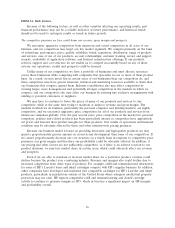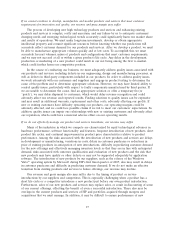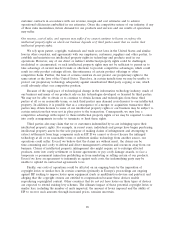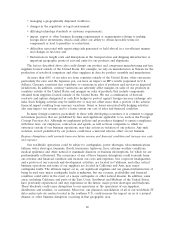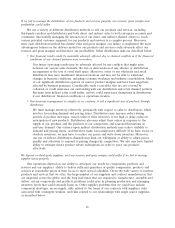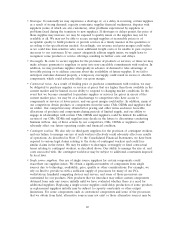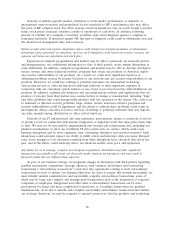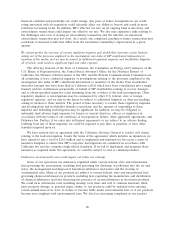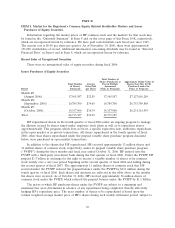HP 2006 Annual Report Download - page 28
Download and view the complete annual report
Please find page 28 of the 2006 HP annual report below. You can navigate through the pages in the report by either clicking on the pages listed below, or by using the keyword search tool below to find specific information within the annual report.of revenue, earnings and working capital for each financial period difficult, increases the risk of
unanticipated variations in quarterly results and financial condition and places pressure on our
inventory management and logistics systems. If predicted demand is substantially greater than orders,
there will be excess inventory. Alternatively, if orders substantially exceed predicted demand, we may
not be able to fulfill all of the orders received in the last few weeks of each quarter. Other
developments late in a quarter, such as a systems failure, component pricing movements or global
logistics disruptions, could adversely impact inventory levels and results of operations in a manner that
is disproportionate to the number of days in the quarter affected.
We experience some seasonal trends in the sale of our products that also may produce variations
in quarterly results and financial condition. For example, sales to governments (particularly sales to the
United States government) are often stronger in the third calendar quarter, consumer sales are often
stronger in the fourth calendar quarter, and many customers whose fiscal and calendar years are the
same spend their remaining capital budget authorizations in the fourth calendar quarter prior to new
budget constraints in the first calendar quarter of the following year. European sales are often weaker
during the summer months. Demand during the spring and early summer also may be adversely
impacted by market anticipation of seasonal trends. Moreover, to the extent that we introduce new
products in anticipation of seasonal demand trends, our discounting of existing products may adversely
affect our gross margin prior to or shortly after such product launches. Typically, our third fiscal
quarter is our weakest and our fourth fiscal quarter is our strongest. Many of the factors that create
and affect seasonal trends are beyond our control.
Any failure by us to execute planned cost reductions successfully could result in total costs and expenses that
are greater than expected.
Historically, we have undertaken restructuring and other cost reduction plans to bring operational
expenses to appropriate levels for each of our businesses, while simultaneously implementing extensive
new company-wide expense control programs. In July 2005, we announced workforce restructurings as
well as reductions through a U.S. early retirement program. We now expect these programs to involve
the elimination or early retirement of approximately 15,200 positions worldwide through the first
quarter of fiscal 2007. We expect to reinvest a significant portion of the cost savings from these actions
to offset market forces or to be reinvested in our businesses to strengthen HP’s competitiveness,
particularly through hiring in key areas. We may have further workforce reductions or rebalancing
actions in the future. Significant risks associated with these actions and other workforce management
issues that may impair our ability to achieve anticipated cost reductions or may otherwise harm our
business include delays in implementation of anticipated workforce reductions in highly regulated
locations outside of the United States, particularly in Europe and Asia, and increased costs associated
with workforce reductions in those locations, redundancies among restructuring programs, decreases in
employee morale and the failure to meet operational targets due to the loss of employees, particularly
sales employees.
During HP’s third fiscal quarter of 2006, we announced a multi-year plan to reduce IT spending by
consolidating HP’s 85 data centers worldwide into six larger centers located in three U.S. cities, a
four-year program to reduce real estate costs by consolidating several hundred HP real estate locations
worldwide to fewer core sites, and a plan to integrate the activities carried out by our Global
Operations organization directly into our business segments. Such actions are expected to result in
instances of accelerated depreciation or asset impairment when we vacate facilities or cease using
equipment before the end of their respective lease term or asset life. Our ability to achieve the
anticipated cost savings and other benefits from these initiatives within the expected time frame is
subject to many estimates and assumptions, including assumptions regarding the costs and timing of
activities in connection with these initiatives. These estimates and assumptions are subject to significant
economic, competitive and other uncertainties some of which are beyond our control. If these
24




